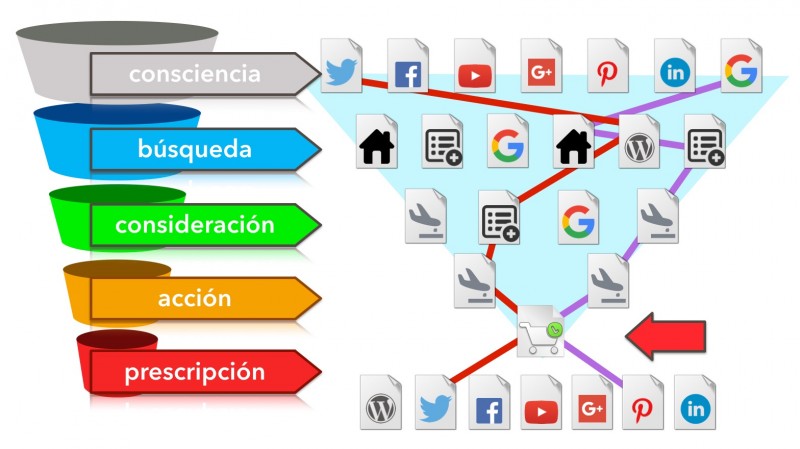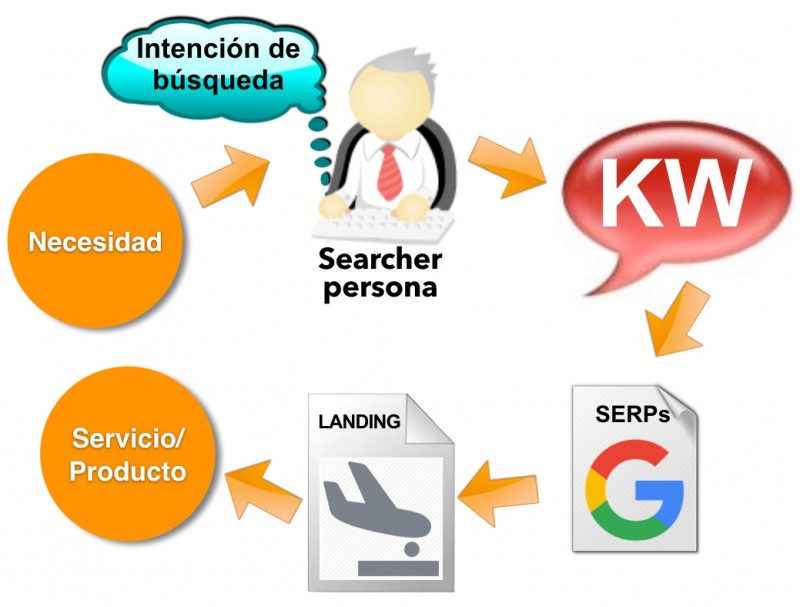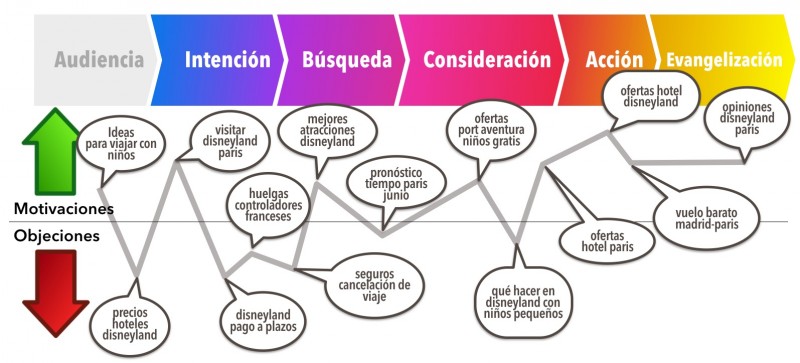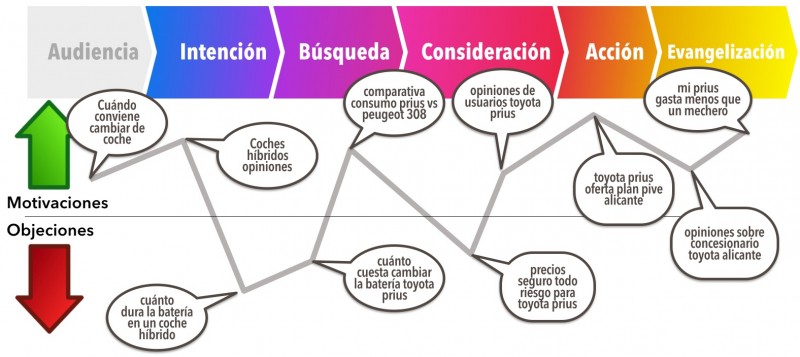Written by Fernando Maciá
Index
This is the Spanish transcript of my presentation in English at The Inbounder event held in Valencia on May 19, 2016. You can view the Customer Journey Analysis and Search Scenarios presentation in Spanish or Customer Journey Analysis and Search Scenarios in English which was originally presented.
Users prefer to shop in an environment where they feel they are making their own purchasing decisions in an informed and free manner. Online advertising is increasingly perceived as intrusive and when advertising comes through the door, users flee through the window . What users really demand is to have the right information at the right time.
If we are able to anticipate what kind of information would be required by users then we could optimize our Web sites not only to be visible in a wider variety of searches but also to accompany users from the first contact until they are ready to make their decision, to become customers. The analysis of the “buyer’s journey” and the definition of search scenarios opens up a new approach to SEO that is much closer to the user’s purchasing decision process.
From the conversion funnel to the customer journey
The analysis of any purchase decision process shows us several things:
- Customer behavior is often inscrutable. Often, it is almost impossible to identify the circumstances, the announcement, the news, the documentary, the specific event that awakened the user’s intention to search for something specific for the first time. How, at a certain point, users realize they have a certain need and start their own “customer journey” from the first search to the final purchase decision.
- An astute salesperson will accompany his or her customer and watch for any signs of purchase motivation or objection. You will try to amplify any buying motivation through your sales pitch and will have enough ready-made arguments to counter any objections.
- Customers’ purchasing decisions are driven by their motivations, even when they are not yet aware of exactly what those purchasing motivations are.
- Customers’ purchasing decisions are often stopped or delayed by their objections, their doubts or when they perceive that they should have more information before they can make a decision.
- Customers need information and will require more information when they believe there is a risk if they make the wrong purchase decision or when they think there is an opportunity for greater benefit if they make the smarter decision.
- Sometimes, taking the customer to the purchase decision requires a step-by-step approach rather than a direct conversion at the first contact.
On the Internet, there are no sellers. All we have are websites, mobile applications, social network profiles, content and functionalities. We cannot sense, at least for the moment, whether a user’s mouth is watering at the latest iPhone model or whether they are terrified at the price. Although users have gained prominence in Web 2.0, the online sales process is still primarily a one-way process.
This means that we have to find ways to identify what the users’ motivations and objections are. We should be able to know how much information users will need so that they can feel comfortable making their purchasing decision.
A funnel or a strainer?
As marketers, we have been describing this process as a funnel, the conversion funnel.
conversion funnel
. In which certain content and search types are key in each of the stages of the funnel. For example, the search intent could be triggered by the user seeing a blog, a TV ad or some related search. Generally, when we start searching to document a purchase decision, the first searches are often very generic. As we identify which features best suit our needs, we then focus our searches to consider only the right options. And finally, we are ready to act, to become customers and even to share our purchase decision on social networks.
Customers react differently to different sales pitches. While for some people buying a €15 T-shirt is an impulse buy, for others more fortunate this threshold is much higher, in the hundreds of euros. The threshold that separates an impulse purchase from one that requires some thought process is different for each user but, in general, the higher the price, the longer the “customer journey”. If we believe that a purchase decision involves a high level of risk, then we will take the time and invest the necessary resources and effort to search, compare and find answers to all our objections, so that we can be sure to make the right decision.
For each purchase decision, a customer will follow a path that is not linear. On the other hand, it is more of an intricate path in which the customer will interact with numerous pages and sources to gather the information he considers relevant: specifications, functionalities, user comments, expert analysis, opinions of his contacts in social networks, comparisons…
And as we saw in the previous joke, it will often not be easy to identify a direct cause-effect relationship between an initial search and a final purchase intention. The Web is the perfect environment for procrastination so the traditional tools and methods we have used in SEO to research keywords are no longer sufficient. Synonyms, semantic field, related words, etc. are not the complete answer.
This means that perhaps we should call the conversion funnel model into question. In real life, we use funnels so that none of the liquid we are pouring spills out. But when we refer to the conversion funnel and find that the average conversion rate of e-commerce in Spain is around 1%, the funnel metaphor is no longer valid. Most of the visitors we attract to the funnel will in fact abandon it at some point. Actually, the funnel looks more like a sieve!
SEO is no longer just about keywords!
And yet, here we are, all of us SEOs trying to position our websites in the top positions for the same most popular and highest converting searches. This approach makes our positioning strategy very linear:
- We identify someinitial keywords that we take as seeds to use in our favorite keyword suggestion tools, whatever they may be.
- We found related keywords with them and selected the best content on our Web sites for each of them, the pages that would convert best.
- We optimize each page for your target keyword, putting the right keywords here and there, in the prominent and relevant areas of the page.
- And we try to increase the authority of the page with internal and external links.
But getting top positions is becoming more and more difficult. Organic results are no longer the main content in the SERPs and even if we get the first organic result this no longer guarantees a good CTR.
Mobile, localized, personalized, shopping, travel, etc. results make it increasingly difficult to control the position we occupy. And there are domains that concentrate so much authority and popularity that there is little chance that they will not monopolize certain search categories.
Keyword suggestion tools work by identifying synonyms, semantic field and other semantic relationships between keywords. However, many of the relationships between the different searches that make up the customer journey do not share a semantic relationship The relationship between them, but rather a sequential or chronological relationship, in which they bridge the gap between each micro-moment and the one that follows it until the moment of conversion is reached.
The customer journey
That’s why we have to broaden our SEO work and look at it from a global perspective. We have to use our knowledge to build likely and popular search scenarios, in which we can identify all the micro-moments that make up the overall purchase decision process.
For example, for a travel Web site, a search such as “disneyland offer” would be very tempting. And it would be an appropriate search as long as it is one of the leading sites in the industry. But if this is not the case – and if it is not positioned in top positions, then it is not – then we must find additional opportunities to be found by our potential customers.
If we analyze the customer journey that brought our user to this search – “disneyland offer”- we find that, in reality, it is only the last search of a process that perhaps began two or three months ago, on some rainy Sunday, looking for ideas for traveling with children on the Internet. Perhaps our friend found a post that talked about what a great idea it is to combine Paris as the perfect romantic destination with spending a few days at Disneyland with the kids.
The blog initiates awareness of the need, the possibility of traveling to Paris next summer. And this is the trigger where this customer’s journey could have begun. You will then need to answer a few additional questions:
And there would still be some additional related searches, such as “cheap flight paris”….
Finally, it is possible that both during their trip and immediately after returning home, they shared their experience, comments and opinions about Disneyland Paris.
As we can see, there are searches that connect more with motivations: “What clothes should we wear?” or “What is the best time of the year to go?” while others are more related to possible objections: “What will the weather be like in June?” “Could there be a strike?”
This means that we should not focus exclusively on a particular keyword but instead consider that we have many micro-moments – all of which make up this customer journey – and each of these micro-moments represents, in itself, an opportunity to make our website visible at different stages of the decision process, and for simpler, less competitive keywords.
It’s the content, stupid
So it’s not really about generating the best content or a lot of content. Not even to produce viral content. All this is good to increase the chances of being found, but what we really need to do is content that helps generate salesWe provide content that connects with users’ motivations, answers all their doubts and objections and makes them feel that no one is pressuring them to buy, but that we are simply providing them with the information they need to make the best purchase choice.
So we should not focus on generating good or a lot of content, but on generating the right content and linking to it internally from the right points. Sales arguments that connect with users’ buying motivations will move that decision forward, while objections will hinder and slow it down.
If we are able to identify those motivations and amplify them, then we can move the customer more quickly toward a purchase decision. If we are not able to counter-argue their objections, the purchase decision could be postponed sine die.
Let’s look at another example, then. For the last year, I’ve been thinking about replacing my old Honda, but this thing is so well built, there’s no way it’s going to break anything. I just can’t find a good excuse to change cars. This does not prevent me, while waiting for that moment to come, from enjoying myself like a dwarf researching and searching for any good candidate on the Internet. At this point you could ask me anything you want about hybrid cars, how many kilometers you have to drive to buy a diesel, which brands are the most reliable, if I should buy, lease or rent one…
So I think it would take hundreds of steps and interactions to show my own customer journey. We could visualize the main steps in a simplified way more or less like this:
So it is easy to see that it doesn’t really make sense to concentrate all our efforts on trying to position ourselves for the most obvious search: “toyota prius offers in alicante”. There are dozens of additional related and anticipatory searches. If we are able, to some extent, to predict this scenario, we can then prepare our Web sites to be visible and findable for many of the micro-moments that make up the customer journey.
Of course, this approach has numerous implications for both the information architecture of the Web site and the structure of the different page templates used.
This is the first part of the post. In the second part we will talk about search scenarios and how to use them to identify all these related and anticipatory keywords that can be a competitive advantage in positioning.







